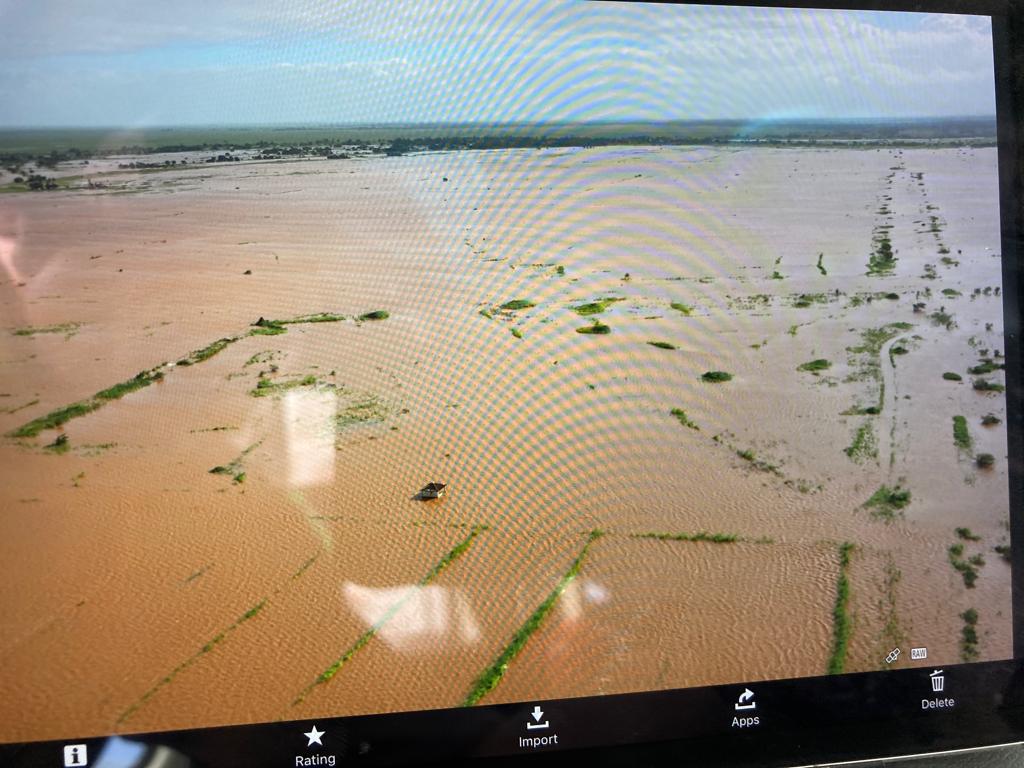Planning ahead in 2021 was the order of the day. Planning is a funny thing. Sometimes it may look as thought we aren’t doing very much. And for a lot of the year, were slowly getting ready for the disaster season.
But in the disaster season we need to look ahead. To plan.
So how are we planning ahead in 2021?
We saw the first issue in the Mercy Air photographs before ELOISE. The ground is wet. Like really wet. Then ELOISE hit and we responded.

The next issue is trying to get some context. The rivers are an obvious problem. We have been pointed to the daily updates by the Mozambican authorities. So we can now study the relationships between the season and the daily changing water levels.
On the 2nd and 3rd of February, the water level at one sampling point on the Limpopo was 3-4 metres above the alert level. The water level is going up and down quite quickly, but the people living on the flood plain are vulnerable.
The people of Mozambique remember the 2000 floods when someone was born up a tree. That was the genesis of our involvement in the region too. That was in the Limpopo and southern areas of the country too. We have some experience there too. We responded to the flood on the Limpopo in 2013.

So we have updated our data on the population living on the flood plain. Some say that 250,000 people were affected by the 2000 flood. The total Mozambican population in 2000 was 17.1 million. In 2021 the total is over 30 million. And as far as we can see the updated population in the flood plain is about 1.1 million people. The land is fertile. The fertilizer is free. Silt comes down the river and floods fertilise the ground. So why wouldn’t people want to live and farm there. Sadly currently the upper Limpopo water levels are kind of mirroring the 2000 levels at this time in the season.

The next issue is how high are the dam water levels? Many rivers in Africa have well established hydroelectric plants to make power. But those dams can be old so you can’t wisely use all the capacity. Old or new, the water levels need careful management. And they get it. There are 3 dams on the tributaries of the Limpopo. And today the Limpopo river system dams are about 2/3rds full. So there is some capacity to take big rainfalls. It looks like about 1300 million tons of water capacity if the dams are allowed to fill to 100%. Yes, big numbers. But that’s good.
The UN ROSEA has also provided some really helpful data. Like usual. That’s the UN’s Regional Office for the Coordination of Humanitarian Affairs (OCHA). It covers 25 countries (regional office – the RO bit of ROSEA). And those countries are in southern and eastern Africa (the SEA bit of ROSEA). This data comes from the Meteo France team on the island of Reunion in the Indian Ocean. They run a cyclone prediction service for the region. Their data indicates that this year the cyclone activity is below normal at this time in the season.
But for Wings one of the drivers is the El Nino Southern Oscillation. What does this water temperature change off South America imply for the weather in the Indian Ocean? Well, it’s our experience that it is La Nina which drives more extreme weather issues off Mozambique. And the La Nina predictions are 90%. That’s data from the World Meteorological Organisation. WE aren’t meteorologists but we have seen a few disasters.
Part of our planning ahead for 2021 is gathering the data. That’s the relatively easy bit.

So what?
Turning data into information is harder than gathering data. Well… we are not prophets. And this is a mixed bag of data.
So what might we conclude?
- Well, vulnerability seems to be writ large. A lot of people are at quite a reasonable amount of flood risk.
- There may be capacity in the dams. And the cyclone season (so far) looks like being below average.
- However, the fundamental driver of La Nina may make the next 7 weeks (to the end of the normal disaster season) ones where vigilance will be necessary.
Sadly COVID is a factor for us in UK.
- Not only are cases of the South African variant appearing in UK.
- But also we have our own UK variant which we do not want to take to Africa.
- The quarantine coming back isn’t the issue,
- However, the risk of quarantine going out might be, because it will slow our response,
- But the nightmare thought is introducing the UK variant into African countries with under resourced health systems.
- It just doesn’t bear thinking about.
That’s the result of our planning ahead in 2021. We hope it helps you understand.
Please take care with the above tentative work…
All this data are time sensitive. Things can change quickly. And what’s worse information is very perspective dependent. So please get in touch if you want to ask more.
Also we are a tiny outfit. And we only have fifteen years of experience. So we do our best, but we can be massively wrong. Sorry, but it’s true.
But if you are a bit concerned, why not donate now? So we can be ready and help our allies be there.






0